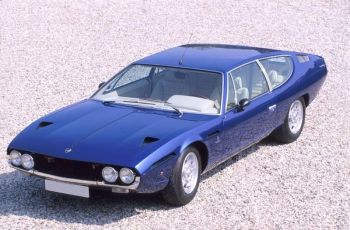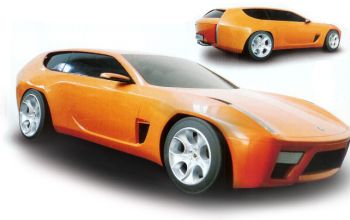|
Lamborghini have
presented design models that offer pointers to a new 2+2
coupe model that unashamedly draws on the original Espada for
inspiration.
In fact so much
so that Lamborghini design staff themselves actually refer
to the project as the 'new' Espada. With its sweeping lines,
huge overhangs and two door format, the scale models
successfully bring one of the marque's most fascinating
historic models right back to the attention.
This new Espada,
if it is given the green light by the sportscar maker's
bosses at Audi, could be presented as early as 2008. Like
the original it will
be a hatchback, but interestingly Lamborghini's engineers
are considering dispensing with the use of conventional door
pillars, and instead follow a path recently trodden by
the highly successful Mazda RX-8, by utilising the rear,
small 'suicide' door approach.
Power will be
delivered by the Gallardo's 5.0-litre V10 and the Murcielago's
6.2-litre V12 engine, both of which will by then have
benefited from a performance upgrade, while traction will be
fed to the wheels via Lamborghini's stock four wheel drive
system.
The new V10 Espada will be a direct competitor to the Aston
Martin DB9 as well as Maserati's forthcoming 5000GT. The
more powerful V12 engined version, to be built in limited
numbers, will take on Ferrari's recently introduced
5.75-litre V12-powered 612 Scaglietti. One of the reasons
Lamborghini have decided on also offering the Murcielago's
fearsome engine, which currently boasts in excess of 600
bhp,
is that the decision has been made that, right across the
range, their models should go head-to-head with the Prancing
Horse marque in the power stakes.
The new project has been designed around the VW-Audi Group's
new D4 'architecture' set. These are prestige market-end
floorpans that are expected to be used by Audi for the
next A8 saloon, Bentley for the Arnarge replacement, VW for
the next-generation Phaeton, if this project is
given the go-ahead after the disastrous sales that are being
achieved by the first model to bear this name, and Bugatti, for a planned 'entry-level'
sportscar, which will complement the 'future' Veyron. However
these underpinnings do not technically approach the highly
sophisticated transaxles, and perfect weight balance of
42/58 percent, that has been achieved by Ferrari with its
new 612 Scaglietti, a feat which is expected to be mirrored
by the forthcoming Maserati 5000GT.
|
 |
|
Lamborghini introduced the original Bertone-styled
Espada model 37 years ago, in 1968 |
|
 |
|
|
 |
|
Lamborghini recently released design models that
offer pointers to a new 2+2 model that unashamedly
draws on the original Espada for inspiration |
|
 |
|
|
Lamborghini
introduced the original Espada 37 years ago, in 1968. It
replaced the 400 GT 2+2, drawing for inspiration on
two 1967 Bertone show cars, the Marzal and Pirana (the
latter being designed for the English "Weekend
Telegraph" using Jaguar mechanicals). The
outrageously-styled coupe, which featured a steel body and
aluminium bonnet, then slotted neatly between the Miura and
the Countach, giving the Raging Bull marque a genuinely
competitive and wide-ranging model range for the first time.
Ironically, a comparison that the Bologna-based marque's
history is repeating itself once more, can easily be made to
the situation that this famous sportscar maker finds itself
in today.
As well as its eye-catching and highly distinctive Bertone
designed bodywork, styled by the legendary Marcello Gandini,
the interior was very luxurious, although this 4.738 mm long,
car was very much a 2+2 coupe and consequently the rear
passengers found their space severely limited.
Technologically, the 153 mph top speed Espada featured
allround independent suspension and beefy disc brakes. Power
came from a front-mounted, quad-camshaft 3.929 cc V12 engine
which powered the aluminium 15-inch rear wheels, via a
5-speed gearbox. This first model, known as the Espada S1,
offered 325 bhp, although the two later versions, the S2 GTE
and S3, saw power increased to 350 bhp, which allowed the car
to dash from 0-60mph in 7.8 seconds.
The Espada S2
GTC which was introduced at the Brussels Motor Show in 1970,
featured a host of improvements including disc brakes
all-round, and a new dashboard.
The third and final Espada version, targeted at the US
market, was premiered at the Turin Motor Show in 1973, and
once again it featured an all-new dashboard, this time of a
design that 'wrapped' itself around the driver.
Cosmetic revisions were made at the front end, while an
electric sunroof and automatic suspension became additional
options. Eventually just over twelve hundred Espadas were
built during the model's ten year production lifecycle.
|
|
|
|
![]()
![]()